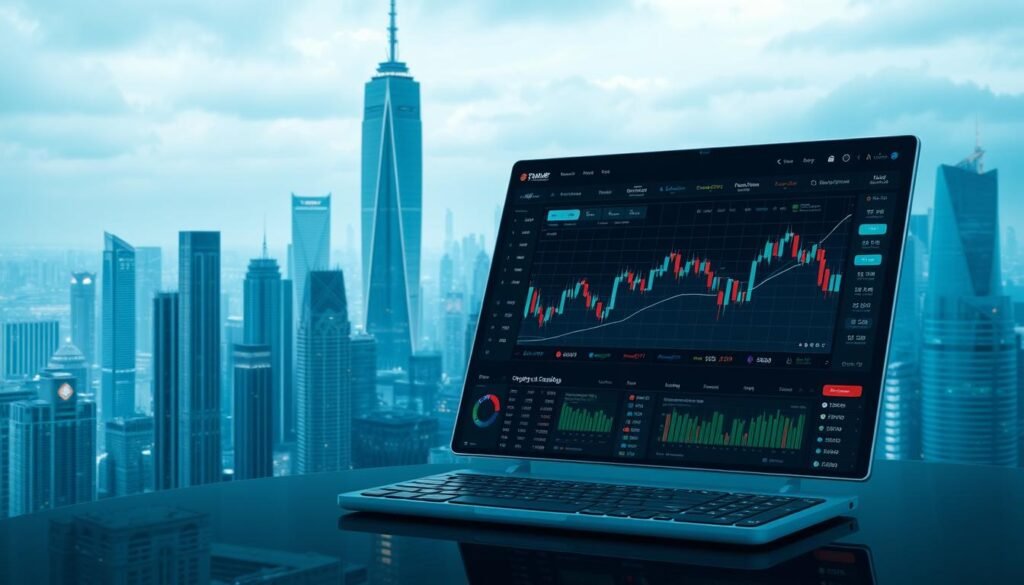Leverage Crypto Trading for Bigger Profits: Ultimate Guide
Did you know that leveraged crypto trading can make your profits bigger? But, it also ups the risk of big losses? This ultimate guide will show you the world of cryptocurrency margin trading. It will help you see its good sides and dangers.
Using leverage in your trades can lead to bigger profits. But, it’s key to know the strategies and risks. Our guide will give you a full view, helping you make smart choices in crypto trading.
Key Takeaways
- Understand the concept of leveraged crypto trading and its potential benefits.
- Learn about the risks associated with cryptocurrency margin trading.
- Discover strategies to maximize profits while minimizing losses.
- Get insights into managing risk and leveraging your trades effectively.
- Understand the importance of a well-planned trading strategy.
Understanding Crypto Trading with Leverage: Core Concepts
Leverage trading in cryptocurrency can greatly increase your gains. But, you need to know its basics well. Learning how to use leverage wisely is key to making the most of your investments.
What is Leveraged Trading in Cryptocurrency?
Leveraged trading in cryptocurrency means using borrowed money to increase your investment’s potential return. This lets traders take on bigger positions than their actual capital. But, remember, leverage can also increase your losses.
To start leveraged trading, you need a margin account with a crypto exchange that offers leverage. The exchange will lend you money for bigger positions. You must keep enough equity in your account to cover losses.
How Leverage Multiplies Potential Returns
Leverage lets you control bigger positions with less capital. For example, with 10x leverage, a $1,000 investment can manage a $10,000 position. If the market goes your way, your gains can be huge. But, if it goes against you, your losses can be just as big, possibly bigger than your initial investment.
- Potential for higher returns: Leverage lets you take on bigger positions, leading to bigger gains.
- Increased risk: The same leverage that boosts gains can also increase losses.
- Margin calls: If your losses eat away your equity, you might get a margin call. This means you need to add more funds or close your position.
Key Terms in Leverage Trading
To do well in leverage trading, you need to know some key terms:
- Margin: The capital needed to start and keep a leveraged position.
- Leverage ratio: The ratio of borrowed money to your own capital. Ratios like 2:1, 5:1, and 10:1 are common.
- Margin call: When the exchange asks for more funds if your equity falls too low.
- Liquidation: When the exchange closes your position automatically if your equity can’t cover losses.
Knowing these core concepts and terms is key to making good leverage trading strategies. Understanding leverage and managing risks helps you navigate crypto trading better. It also helps you choose the best platform for leveraged trading.
As you dive deeper into crypto trading, mastering leverage is crucial for high profits. Whether you’re new or experienced, knowing how to trade crypto with leverage can greatly improve your trading skills.
The Mechanics Behind Leveraged Cryptocurrency Trading

Leveraged crypto trading uses margin and leverage ratios. It lets you borrow funds to increase your trading position. This can lead to bigger returns.
Margin is key in leveraged trading. It’s the capital needed to start and keep a leveraged position. For instance, to trade $1,000 worth of crypto with 10x leverage, you might only need to put up $100 as margin. The rest, $900, is borrowed from the exchange or broker.
Leverage ratios differ by exchange and asset. You might see 2x, 5x, 10x, or even higher ratios. Higher leverage means bigger potential returns but also bigger risks. It’s important to remember that leverage can increase both your gains and losses.
Using leverage means you face the risk of liquidation if the market goes against you. Liquidation happens when your margin value drops too low. This closes your position to stop further losses. That’s why managing risk is so important in leveraged trading.
Traders use strategies like stop-loss orders and watching their positions closely. Knowing about margin and leverage is key to navigating leveraged trading. It helps you make better decisions.
Understanding leverage and managing its risks can help you use it to your advantage. Whether you want to increase your gains or protect against losses, knowing how leveraged trading works is essential.
Essential Tools for Successful Leverage Trading
To do well in leverage trading, you need the right tools. These tools help you understand the market and manage risks. Leverage trading uses borrowed money to increase potential gains but also ups the risk. So, having the right tools is key to making smart choices and avoiding big losses.
Technical Analysis Tools
Technical analysis tools are crucial for spotting trends and making trading decisions. They include charts, indicators, and more. These tools help traders look at past data to guess future market moves. Some top tools for leverage trading are:
- Moving Averages
- Relative Strength Index (RSI)
- Bollinger Bands
- MACD (Moving Average Convergence Divergence)
Table: Popular Technical Analysis Tools
| Tool | Description | Usage |
|---|---|---|
| Moving Averages | Average price of a security over a specified period | Identifying trends |
| RSI | Measures the magnitude of recent price changes | Identifying overbought/oversold conditions |
| Bollinger Bands | Plots two standard deviations around a moving average | Measuring volatility |
Risk Management Software
Risk management is vital in leverage trading. It helps control losses from using borrowed money. Risk management software tracks exposure, sets stop-loss orders, and adjusts strategies. Key features include:
- Real-time position monitoring
- Automated stop-loss orders
- Risk assessment and reporting
Portfolio Tracking Systems
Portfolio tracking systems give a real-time view of your investments. They help spot risks, rebalance portfolios, and guide investment decisions. Key features include:
- Real-time portfolio valuation
- Performance analytics
- Alerts and notifications
Using these tools can improve your leverage trading. They help make better decisions and manage risks more effectively.
Selecting the Right Leverage Trading Platform

Finding the right leverage trading platform is key to success in the crypto market. It’s important to pick a platform that fits your trading style and how much risk you’re willing to take.
Top Crypto Exchanges for Leverage Trading
Many crypto exchanges offer leverage trading, but they’re not all the same. Look at liquidity, how easy it is to use, and customer support. Some top exchanges for leverage trading are:
- Binance: Known for its high liquidity and wide range of trading pairs.
- BitMEX: Offers high leverage options and a robust trading engine.
- Bybit: Provides a user-friendly interface and competitive fees.
It’s important to compare these exchanges to find the best one for you.
Security Features to Consider
Security is crucial in leverage trading. Look for platforms with strong security features like:
- Two-Factor Authentication (2FA) to protect your account.
- Encryption to keep your data safe.
- Regular security audits to ensure the platform’s integrity.
A leading security expert says, “A secure trading platform is not just a feature, it’s a necessity.” Choosing a platform that values security will protect your assets.
Fee Structures and Requirements
It’s important to understand the fees of your chosen platform. Different exchanges charge different fees for trading, withdrawals, and leverage. Consider the following:
- Trading fees: Some platforms charge more for leverage trading.
- Deposit and withdrawal fees: Check if there are fees for adding or taking money out.
- Margin requirements: Know the minimum margin needed to keep your leveraged positions.
By looking at these factors, you can choose a platform that meets your needs and helps you manage risk.
Risk Management Strategies in Leveraged Trading

In the world of leveraged cryptocurrency trading, it’s key to manage risks well. This kind of trading can lead to big wins or big losses. It’s important to have a solid plan to navigate the markets.
Understanding Leverage Risks
First, we need to know the risks of using leverage in crypto trading. Leverage lets traders handle big positions with a small amount of money. But, it also means big losses can happen fast. Without careful management, these losses can be more than the initial investment.
One top tool for managing risk is the stop-loss order. It closes a trade when the price hits a certain point, capping losses. By using a stop-loss, traders can set a limit on how much they can lose on a trade.
Position Sizing: Managing Exposure
Position sizing is another key strategy. It’s about figuring out how big a trade should be based on risk and account size. This helps avoid big risks and makes trading more stable and consistent.
- Determine your risk tolerance per trade.
- Set a stop-loss level for each trade.
- Calculate the position size based on your risk per trade and stop-loss level.
Diversification and Risk Management
Diversifying investments is also a smart move. It means spreading out investments across different assets. This can help lessen the impact of bad market moves in one area, like a specific cryptocurrency.
To use these strategies well, it’s wise to take a leverage trading tutorial. This will teach you the ins and outs of leveraged trading and how to manage risks. With these skills, traders can improve their performance and tackle the challenges of leveraged crypto trading with more confidence.
Advanced Leverage Trading Techniques

Exploring crypto trading with leverage opens up new ways to make money. Leveraged crypto trading is complex and needs a good grasp of the market.
To master leveraged crypto trading, you must know advanced techniques. These include long and short positions, trading multiple assets, and hedging with leverage.
Long and Short Positions
Long and short positions are key in leveraged crypto trading. A long position means buying a crypto hoping its value will go up. A short position means selling a crypto hoping its value will go down.
Let’s look at an example:
| Position Type | Market Expectation | Potential Outcome |
|---|---|---|
| Long | Price will rise | Profit from increased value |
| Short | Price will fall | Profit from decreased value |
Multiple Asset Strategy
Diversifying your portfolio by trading different cryptos is called a multiple asset strategy. It helps spread risk and can increase potential gains.
Trading multiple assets lets you grab different market chances. It also reduces your dependence on one crypto.
Hedging with Leverage
Hedging with leverage uses borrowed money to protect against losses or lock in profits. It’s a way to manage risk and safeguard your investments.
For instance, if you’re worried about a crypto’s price dropping, you can open a short position. This helps protect against losses.
Learning these advanced techniques can boost your trading skills. It can lead to more success in the cryptocurrency market.
Common Pitfalls and How to Avoid Them
To succeed in leverage trading, you must know the common mistakes and how to dodge them. Trading with leverage in cryptocurrency can boost your profits. But, it also brings big risks if not handled right.
One big mistake is over-leveraging. This happens when you borrow too much money. It makes big losses possible, just like big gains. Knowing your risk level and adjusting your leverage is key.
Poor risk management is another big error. Without a good plan, you can lose a lot. Using stop-loss orders and setting the right position size are important for managing risk.
Understanding the market and what you’re trading is also crucial. Insufficient market analysis can lead to bad choices. Keeping up with market trends and using technical tools can help avoid this.
| Common Pitfalls | Strategies to Avoid |
|---|---|
| Over-Leveraging | Understand your risk tolerance, adjust leverage according |
| Poor Risk Management | Implement stop-loss orders, use position sizing |
| Insufficient Market Analysis | Stay informed about market trends, use technical analysis tools |
Knowing these common mistakes and how to avoid them can greatly improve your trading success. The secret to making money with leverage is not just about making more. It’s also about managing risks well.
Market Analysis for Leverage Trading Success
Effective market analysis can greatly improve your trading results. It gives you the insights needed to make smart decisions.
To do a good market analysis, you need to know and use several key techniques. These include technical indicators, fundamental analysis, and understanding market sentiment.
Technical Indicators
Technical indicators are key for spotting market trends and predicting price changes. Some top indicators are:
- Moving Averages: Show trends and support and resistance levels.
- Relative Strength Index (RSI): Tells if prices are too high or too low.
- Bollinger Bands: Measure market volatility and spot breakouts.
Example of Technical Indicators in Action:
| Indicator | Description | Usage |
|---|---|---|
| Moving Average | Identifies trends | Buy when price crosses above MA, sell when it crosses below |
| RSI | Measures price change magnitude | Sell when RSI > 70, buy when RSI |
| Bollinger Bands | Assesses volatility | Buy when price touches lower band, sell when it touches upper band |
Fundamental Analysis
Fundamental analysis looks at a cryptocurrency’s true value. It studies economic, financial, and other factors.
“The biggest risk is not taking any risk… In a world that’s changing really quickly, the only strategy that is guaranteed to fail is not taking risks.” – Mark Zuckerberg
This analysis helps traders see if a cryptocurrency is cheap or expensive. It makes predicting prices easier.
Market Sentiment Assessment
Market sentiment assessment checks how traders feel about a cryptocurrency. You can do this through:
- Social Media Monitoring: Look at what people say on Twitter and Reddit.
- Market Surveys: Ask traders what they think.
- Sentiment Indicators: Use tools to measure how people feel.
By using technical indicators, fundamental analysis, and market sentiment, you can create a strong strategy. This will help you succeed in leverage trading.
Building Your Leverage Trading Strategy
Creating a leverage trading strategy needs several key parts. These include how much to invest in each trade and how to manage risks. It’s important to balance risk and potential gains.
Position Sizing
Position sizing is key in leverage trading. It decides how much money you put into a trade. Proper position sizing helps control risk and avoid big losses. Think about your total money, how much risk you can take, and your crypto leverage exchange‘s offer.
It’s wise to risk only 1-2% of your total money on one trade. This way, you can handle market ups and downs without losing too much.
Entry and Exit Rules
Clear rules for when to enter and exit trades are crucial. Your entry rules should come from detailed market analysis. This includes technical indicators and market sentiment. Exit rules should aim to lock in profits or limit losses.
For example, you might set a stop-loss order to close a trade when it hits a loss limit. You can also use take-profit orders to secure gains when the market goes your way.
Risk-Reward Ratios
Understanding risk-reward ratios is key to judging trade success. A risk-reward ratio shows if a trade is worth it based on its potential gain versus risk.
Many traders use a 1:2 ratio. This means risking one dollar could gain two. This ratio helps keep your trading positive over time.
| Risk-Reward Ratio | Description | Example |
|---|---|---|
| 1:1 | Equal risk and reward | Risking $100 for a $100 gain |
| 1:2 | Double the reward compared to risk | Risking $100 for a $200 gain |
| 1:3 | Triple the reward compared to risk | Risking $100 for a $300 gain |
By focusing on position sizing, entry and exit rules, and risk-reward ratios, you can craft a solid leverage trading strategy. This strategy boosts your chances of success in the cryptocurrency market.
Conclusion: Mastering Leveraged Crypto Trading
You now know the basics of crypto trading with leverage. It can increase your profits. By using the strategies from this guide, you can manage risks and get the most out of your trades.
To get good at leveraged crypto trading, make a solid plan. Use important tools and keep up with market news. Choosing the right platform and managing risks are key to success.
Keep improving your skills in crypto trading with leverage. Stay focused and adjust to market changes. With time and effort, you can master leveraged crypto trading and reach your financial goals.


Pingback: Dive into DeFi: A Comprehensive Guide to Investing